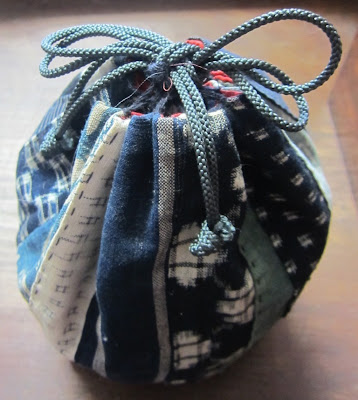Customers often ask me what kind of sewing I do and they're often surprised that I don't make kimonos, that I'm not a quilter and that I rarely sew with silk. The truth is that I do very little sewing! I'm usually kept busy enough preparing fabric for the shop - and being a mum. I never use a sewing machine unless I really really have to. My taste and temperament leans very much towards more rustic handstitching. I'm very interested in all traditional Japanese techniques for re-using and recycling old fabrics but I'm not good at all with little fiddly things (like the oshie in my previous post for example). I love and appreciate so many of these traditional crafts and I guess I could become better at that kind of work if I persevered, but it's not what I enjoy making. Here are some pieces that show what I do enjoy.
I made the first pieces some years ago for an exhibition that my sewing group put on in the shop.
This is a sashiko furoshiki wrapping cloth that I use as a table cloth in the shop. It's about 60cm square and is stitched on a piece of old futon cover. Some years ago I found an article in a Japanese magazine about an old lady from Kyushu who was doing the most amazing random freehand sashiko . I've seen very few other examples of it but I enjoy doing it myself and like how it looks. These coasters and mats were also for the exhibition:
This is a silk komebukuro (rice bag) style drawstring bag that I finished recently. I had started it years ago and purposely left it unfinished for komebukuro workshops. It's quite big ( a useful size for storing things) which made my husband comment that I couldn't really call a bag that size a kombukuro. I like this style of working with random sized strips.
This is the first, much smaller, bag I made for the komebukuro workshop, using antique cottons.
This piece of patchwork is a detail from a quilt (it will be tied not actually quilted) that I've been working on for years and will eventually finish one day - maybe. The squares are about 5 cm square but you can see that precision isn't really my thing! Again, I like the randomness of it.
Lately I've started working on some traditional sashiko cotton hanafukin cloths for a potential workshop. These dishclothes were the kind of stitching that women would sit and work on in the evenings to recycle their cotton remnants. The one on the left is hitomezashi stitching which is a kind of sashiko done in straight lines of vertical and horizontal running stitch on a grid. But again my taste is always to the more simple and I prefer the simple lines of the second one.
I haven't run any workshops for a few years now. We don't have very much space and as the shop got busier it became too difficult to run them when we're open. I'm thinking of starting a limited programme again in the new year. One of the workshops I'm working on is Ainu embroidery. The Ainu are an indigenous people of northern Japan and I will post about Ainu textiles again in future. I still have a lot of work to do to prepare for this workshop - my embroidery skills leave a lot to be desired. These are some of my first attempts - they don't have the same flare as original Ainu pieces - and please don't look too closely at the stitching!















